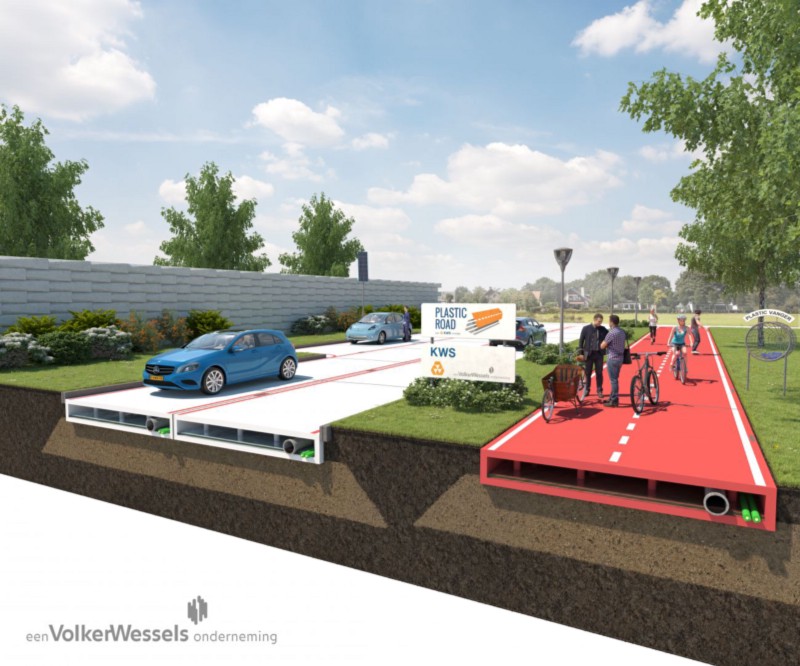

When you think of sustainability, you probably don’t think of roads–in fact, probably the opposite. Images of highways cutting through the countryside and congested streets are often used to highlight the unsustainable nature of modern industrialization.
The numbers tend to back up the images. The asphalt used in roads is responsible for 1.6 million tons of CO2 globally each year–around two percent of all road transport emissions. As Mark Harris writes in The Guardian: “Building and maintaining a single mile of freeway takes as much energy as 200 U.S. homes use in a year, consumes as much raw material as 1,000 households get through in 365 days, and generates more waste than 1,200 homes produce annually.”
Is there a way we can make the process more sustainable?
Engineers and environmentalists have been looking into that for a long time now. In 2010, Greenroads launched in the United States as an organization which “evaluates a road’s overall environmental and social impact, taking into account everything from construction materials and practices, to noise pollution, habitat control, and bike lanes.” It turns out there is actually a whole range of things that can make roads more environmentally friendly, such as their alignment, construction practices, and the materials used to build them.
Yet, usually these make current infrastructure only a little bit greener. That might be about to change. Projects from around the world are seeking to fundamentally alter the impact of our roads.
The Netherlands is leading the world in this charge. The first of these related projects started six months ago when the country built the world’s first solar road (a footpath, to be precise), designed to generate solar energy as people ride over it. About 230 feet long, in its first six months the path generated 300 kilowatt-hours of energy. That’s enough electricity to power a small home for a year, a figure that exceeded even the expectations of the path’s engineers. With more than 2,800 miles of dedicated cycle paths in the Netherlands, a full network of solar paths could generate nearly 20,000 megawatt-hours, an amount comparable to a large nuclear power plant.
The results are great news for further rollout. SolaRoad, the company that built the test path, is now working with councils around the Netherlands to install its technology, and it has also signed a similar deal with the state government in California. A different company with a similar name, Solar Roadways has a bold plan to cover all U.S. roads in solar technology and is fundraising aggressively to make it happen.
But in many ways solar roads are still just a Band-Aid. They don’t fix the underlying problem at the heart of basic road construction. So, the city of Rotterdam has different plans altogether. Working with the company VolkerWessels, Rotterdam is looking to install new roads made from recycled plastic bottles. VolkerWessels says these roads will be much easier and faster to construct, last about three times as long as regular asphalt, require less maintenance, and withstand greater extremes of temperature–between -40 degrees Fahrenheit (-40 Celsius) and 176 degrees Fahrenheit (80 Celsius). On top of that, plastic roads will significantly reduce greenhouse gas emissions and take plastic bottles out of landfills.
The plastic road project has not progressed as far as solar road projects, but a pilot is expected to be ready within the next three years. If those plans come to fruition, the plastic roads will eliminate many of the environmental issues that emerge from road construction.
All, of course, except for the one big problem–the destruction of land that comes with building thoroughfares. While we will never be able to solve that problem (roads inherently take up a lot of earth), there are methods for fixing the damage that has already been done.
Cities around the world, for example, are replacing their old freeways with new public spaces. From Seattle to Madrid, San Francisco to Seoul, big metropolises are doing away with roads running through cities and putting in parks and cultural venues for residents to enjoy. Eliminating roads in this way has major benefits, including “cooling the city, capturing storm water, and helping reduce flooding.” New parks also provide homes for wildlife and clean the air and surrounding waterways. They replace the congestion and pollution of roads with significantly more Earth friendly alternatives.
Roads will never be a full solution to our sustainability issues. Reducing car use and increasing public transport are still essential for a greener future. Yet, there are ways to make this infrastructure a little bit greener. And every bit helps.


How We Get To Next was a magazine that explored the future of science, technology, and culture from 2014 to 2019. This article is part of our Going Places section, which looks at the impact of transportation technology on the modern world. Click the logo to read more.
